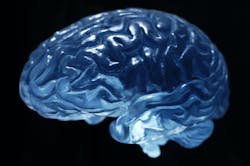Researchers have discovered that a protein called phosphorylated α-synuclein, which is associated with several neurodegenerative diseases such as Parkinson’s disease and Lewy body dementia, is also involved in the normal processes of how neurons communicate with each other in a healthy brain. The research, published in Neuron, was funded in part by the National Institute of Neurological Disorders and Stroke (NINDS), a part of the National Institutes of Health.
Previous work by the lab of Subhojit Roy, M.D., Ph.D., professor at the University of California, San Diego, and senior author of the study, suggested that in a healthy brain, the α-synuclein protein tones down excessive neuronal firing to regulate neuronal communication. While exploring this theory, Roy’s group unexpectedly found that phosphorylation was necessary for the normal function of α-synuclein.
Using a molecular modeling strategy to look at the structure of α-synuclein, Roy and his colleagues led by postdoctoral researcher Leonardo Parra-Rivas, Ph.D. discovered that when α-synuclein is phosphorylated, its structure changes in a way that promotes interactions with other proteins in healthy brains. Furthermore, they observed an association between increasing neural activity electrically or chemically and an increase in the amount of phosphorylated α-synuclein in both cultured cells and in mouse brain tissue. This finding suggests there might be a relationship between synaptic activity and α-synuclein phosphorylation.
Additionally, experiments show phosphorylation is necessary for α-synuclein to play its role in assembling a network of proteins that bind up synaptic vesicles—pockets that release chemicals enabling neurons to communicate with one another and other cells—and to slow neuronal activity. Therefore, phosphorylated α-synuclein acts almost as a brake or clutch mechanism to keep activity in certain neuronal circuits in check, suggesting that it might have a role in healthy brains, which had not previously been investigated.

